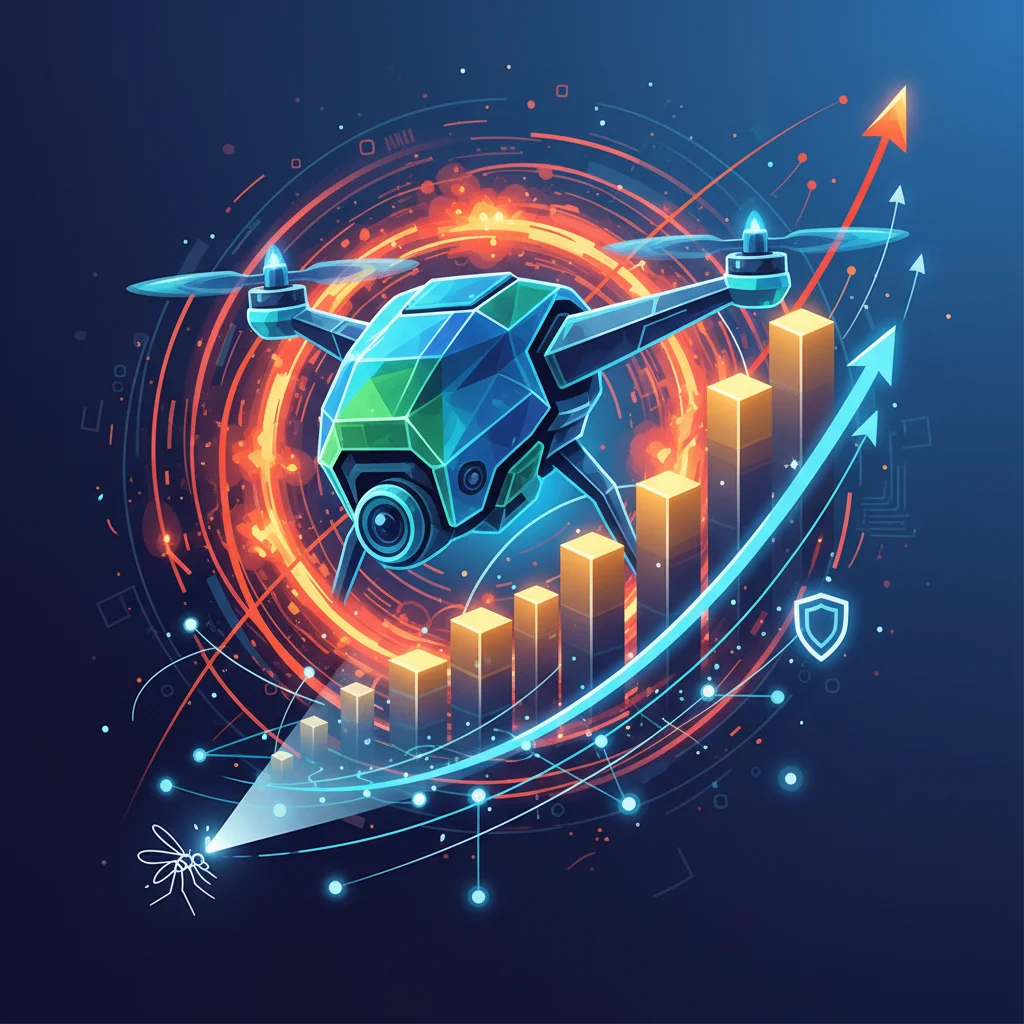
The SaaS of War: How DroneShield Turned AI and RF into a Billion-Dollar Defense Play
What do you get when you cross an idea to zap mosquitoes with lasers, the brutal realities of modern warfare, and a brilliant pivot to a software-as-a-service model? You get DroneShield, a company that started with a quirky concept and has now become Australia’s most valuable defense stock, proving that in the 21st century, the most powerful weapon might just be a subscription to the right software.
It’s a classic startup story with a geopolitical twist. A few years ago, the idea of “counter-drone technology” was a niche concept, something you might see in a sci-fi movie or a security brief for a major airport. Today, it’s one of the most critical and fastest-growing sectors in global defense. Thanks to the widespread use of cheap, commercial drones in conflicts from Ukraine to the Red Sea, the world has woken up to a new and terrifying reality: a $1,000 drone can pose a lethal threat to a billion-dollar warship.
This paradigm shift has catapulted companies like DroneShield from relative obscurity to the forefront of the defense industry. Their shares have surged more than fourfold this year alone, and the company’s journey offers a masterclass in technology, business strategy, and the power of being in the right place at the right time with the right solution.
The New Battlefield: Asymmetric Threats and the Drone Revolution
To understand DroneShield’s meteoric rise, you first need to understand how drastically the battlefield has changed. For decades, military superiority was defined by massive, expensive hardware: fighter jets, aircraft carriers, and sophisticated missile systems. But the war in Ukraine became what DroneShield CEO Oleg Vornik calls the “iPhone moment for drones in warfare”. Suddenly, modified consumer drones were being used for everything from reconnaissance to kamikaze attacks, with devastating effectiveness.
This is the essence of asymmetric warfare. Why spend millions on a missile to take down a drone that costs less than a used car? This economic imbalance has created an urgent, global demand for a cost-effective countermeasure. You can’t just shoot every drone out of the sky; you need a smarter, more scalable solution.
This is where the world of high-tech defense meets the principles of modern cybersecurity and software development. The threat isn’t a single, predictable enemy; it’s a constantly evolving swarm of adaptable, low-cost devices. The only way to fight back is with an equally adaptable, intelligent, and software-driven system.
Europe's Tech Crossroads: Why Building a Better AI, Not Just a Bigger One, Is the Winning Strategy
DroneShield’s Arsenal: A Symphony of RF, AI, and Software
So, how do you stop a drone without firing a shot? DroneShield’s approach is a fascinating blend of hardware and sophisticated software, focusing primarily on a “soft kill” method.
Their systems work in two main phases:
- Detect and Identify: The core of their technology isn’t a camera or a radar, but a highly sensitive radio frequency (RF) sensor. In a world saturated with signals—Wi-Fi, Bluetooth, cell phones, radio—the challenge is to pick out the unique signature of a drone’s control signal. This is where artificial intelligence and machine learning come into play. Their AI algorithms are trained on a massive library of drone signals, allowing them to instantly identify a potential threat, its type, and sometimes even the location of its pilot.
- Defeat: Once a threat is identified, DroneShield’s systems can engage. Instead of launching a projectile, products like their famous DroneGun use focused RF jamming. They essentially blast the drone with targeted radio noise, severing the connection between the drone and its operator. The drone’s typical fail-safe protocol then kicks in, causing it to either land immediately or return to its launch point, allowing for its capture and analysis.
This approach is faster, safer, and far cheaper than traditional “hard kill” methods. To give a clearer picture of their offerings, here’s a breakdown of their key product lines.
| Product | Type | Primary Function |
|---|---|---|
| DroneGun Mk4 | Handheld, Portable | Point-and-shoot drone disruption for tactical situations. |
| DroneSentry-X | Vehicle-mounted / Fixed Site | Automated 360-degree detection and “soft kill” jamming for convoys or buildings. |
| RfPatrol | Body-worn | Passive, wearable drone detector for individual soldiers or security personnel. |
| DroneSentry | Integrated Fixed Site System | Comprehensive, multi-sensor system (RF, radar, cameras) for protecting large areas like airports or critical infrastructure. |
The Ultimate Pivot: From Hardware to a SaaS Powerhouse
For entrepreneurs and tech professionals, the most compelling part of DroneShield’s story is its business model evolution. Initially, the company, like many defense firms, focused on selling hardware. You buy a DroneGun, and that’s the end of the transaction. But the leadership team quickly realized the hardware was just a vessel for their true product: intelligence.
The real intellectual property—the “secret sauce”—is the RFAI (Radio Frequency Artificial Intelligence) engine and its ever-expanding threat database. Every drone has a unique digital fingerprint, and as new drones are released or modified, that library needs constant updating. This realization led to a brilliant pivot to a SaaS model.
Now, customers don’t just buy a piece of equipment; they subscribe to the DroneShield intelligence network. This creates a recurring revenue stream and makes the product “stickier.” The hardware’s effectiveness depends on the latest software updates, which are delivered seamlessly, much like an update to your smartphone’s operating system. This model provides continuous value to the customer and predictable revenue for the company—the holy grail for any tech business.
This shift is what investors find so attractive and is a key reason for the company’s A$1.3bn market valuation. They aren’t just a hardware manufacturer; they are a data and software company that solves a critical security problem.
The AI Takeover: What a Secret Academic Leaderboard Reveals About Our Future
Lessons for Innovators, Developers, and Entrepreneurs
DroneShield’s journey from a quirky idea to a defense-tech titan is packed with valuable lessons for anyone in the tech industry, whether you’re building an app, a B2B platform, or the next big thing in automation.
- Solve a Specific, Urgent Problem: The company didn’t try to compete with Boeing or Lockheed Martin. They identified a new, rapidly emerging threat and focused all their energy on becoming the best in the world at solving that one problem.
- Your Moat is Your Software (and Data): Hardware can be reverse-engineered. A proprietary dataset and a self-improving machine learning algorithm, however, create a powerful competitive advantage that gets stronger over time. The programming and data science behind the scenes are the real assets.
- Embrace the Business Model Pivot: The willingness to shift from a transactional hardware model to a recurring revenue SaaS model was transformative. It aligned their business with modern tech valuations and created a more sustainable, scalable company.
- Innovation Thrives at the Intersection of Fields: This isn’t just a defense company. It’s an AI company, a radio engineering firm, and a software company all in one. The most powerful innovation often happens when you combine expertise from different domains to create something entirely new.
The Cinema vs. Streaming Showdown: Why Your SaaS Startup Should Be Watching
The Future is Software-Defined
The story of DroneShield is more than just a successful stock pick. It’s a profound signal about the future of security, defense, and technology. It shows that small, agile teams armed with brilliant code and intelligent algorithms can outmaneuver industrial giants. It highlights a world where national security increasingly relies on the same technologies powering Silicon Valley: artificial intelligence, cloud computing, and subscription-based software.
From an idea about zapping mosquitoes to protecting soldiers and critical infrastructure around the globe, DroneShield has proven that the most effective defense in the modern era isn’t necessarily the one with the biggest explosion, but the one with the smartest code.


